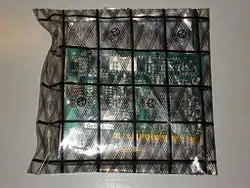Electrostatic discharge materials
Electrostatic discharge materials (ESD materials) are plastics that reduce static electricity to protect electrostatic-sensitive devices (ESD) or contain flammable liquids or gases.


Materials
ESD materials are generally subdivided into categories with related properties: Anti-Static, Conductive, and Dissipative.[1]
| Ohms Per Square | < 10−3 | 10−3 to 1 | 1 to 103 | 103 to 106 | 106 to 109 | 109 to 1012 | > 1013 |
|---|---|---|---|---|---|---|---|
| Material | Metals | Carbons | Shielding | Conductive | Static Dissipative | Anti-Static | Insulative |
| Description | Carbon powders and fiber | No initial charge. Provides path for charge to bleed off. Typically black color. | No or low initial charge. Prevents discharge to or from human contact | Initial charges are suppressed. Typically pink color. | Insulators and Base Polymers. Not an ESD material |
Conductive
Conductive materials have a low electrical resistance, thus electrons flow easily across the surface or through these materials. Charges go to ground or to another conductive object that the material contacts.
Dissipative
Dissipative materials allow the charges to flow to ground more slowly in a more controlled manner than with conductive materials.
Anti-Static
Anti-static materials are generally referred to as any material which inhibits triboelectric charging. This kind of charging is the buildup of an electric charge by the rubbing or contact with another material.
Insulative
Insulative materials prevent or limit the flow of electrons across their surface or through their volume. Insulative materials have a high electrical resistance and are difficult to ground, thus are not ESD materials. Static charges remain in place on these materials for a very long time.
Further reading
- The Wiley Encyclopedia of Packaging Technology; 1st Edition; Kit. L. Yam; John Wiley & Sons; 1353 pages; 2009; ISBN 978-0-470-08704-6.
- Plastics Additives Handbook; 6th Edition; Zweifel, Maier, Schiller; Hanser Publications; 1222 pages; 2009; ISBN 978-1569904305.
- Handbook of Conducting Polymers; 3rd Edition; Skotheim and Reynolds; CRC Press; 1680 pages; 2007; ISBN 978-1574446654.
- Conductive Polymers and Plastics: In Industrial Applications; 1st Edition; Larry Rupprecht; Elsevier; 293 pages; 1999; ISBN 978-0815516569.
- Plastics Additives and Modifiers Handbook ; 1st Edition; Jesse Edenbaum; Springer; 1136 pages; 1992; ISBN 978-0442234508.
- Metal-Filled Polymers: Properties and Applications; 1st Edition; S.K. Bhattacharya; CRC Press; 376 pages; 1986; ISBN 978-0824775551.
External links
